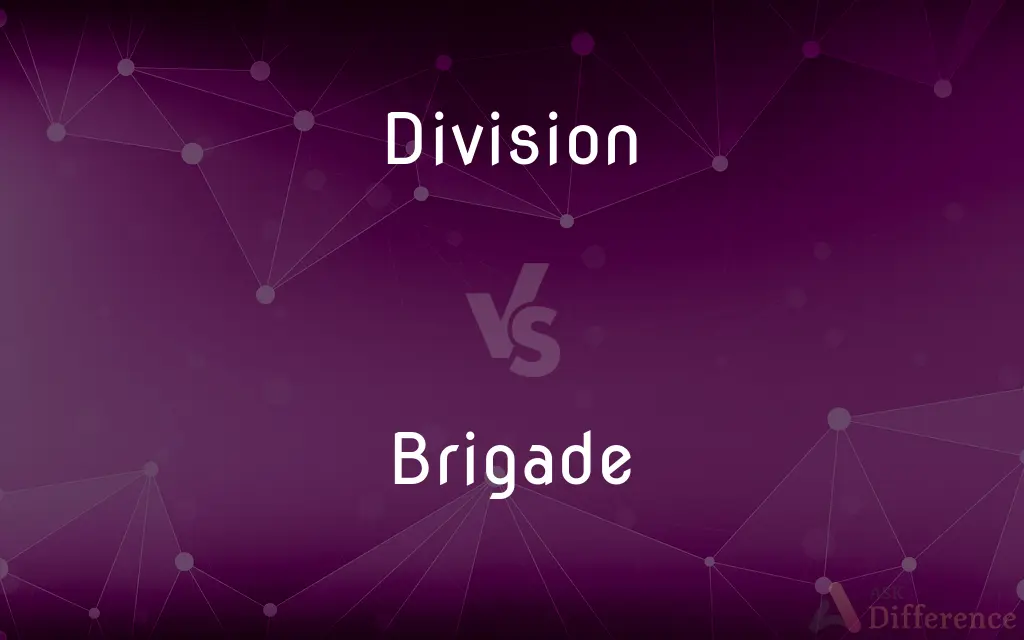Division vs. Brigade — What's the Difference?
By Urooj Arif & Maham Liaqat — Updated on April 5, 2024
A division is a large military unit or formation usually consisting of 10,000 to 20,000 soldiers, while a brigade typically comprises 3,000 to 5,000 troops, serving as a subdivision of a division.

Difference Between Division and Brigade
Table of Contents
ADVERTISEMENT
Key Differences
In military hierarchy, a division stands as one of the largest units, often commanded by a major general. It is structured to perform major tactical operations and sustain combat operations independently. On the other hand, a brigade, which is usually commanded by a brigadier general or a colonel, acts as a crucial subdivision within a division, focusing on specific combat or support roles. While both are integral to military operations, divisions provide broader operational capabilities across a wider range of military disciplines, whereas brigades specialize in specific areas, such as infantry, artillery, or engineering.
Divisions are capable of conducting large-scale operations, equipped with their own support units covering logistics, medical, and intelligence needs. Brigades, while also self-sufficient to a degree, are more focused on executing specific tasks within the larger framework set by divisional objectives. This difference underscores the division’s role in strategic planning and coordination across a broader operational spectrum, compared to the brigade’s focus on tactical execution within these plans.
The composition of divisions and brigades can vary significantly based on the country, branch of service, and specific operational requirements. Divisions are more likely to be mixed with various types of brigades and support units to enable them to operate independently in diverse scenarios. Brigades, being smaller, are often more homogenous, composed of units with similar functions but can also include support elements necessary for their specific missions.
In terms of command structure, the larger size and scope of divisions necessitate a more complex command and control framework to manage their diverse components effectively. Brigades, being smaller, can often react more quickly to tactical situations, with a command structure that allows for rapid decision-making and flexibility in response to changing conditions on the ground.
Historically, the use and organization of divisions and brigades have evolved, reflecting changes in warfare, technology, and military doctrine. Modern military strategies increasingly rely on the flexibility and specialized capabilities of brigades, integrating them into divisional structures or deploying them independently, depending on the mission's demands. This evolution highlights the adaptability of military organizations in response to the complexities of contemporary and future conflicts.
ADVERTISEMENT
Comparison Chart
Ize
10,000 to 20,000 soldiers
3,000 to 5,000 troops
Command
Major General
Brigadier General or Colonel
Function
Major tactical operations, sustained combat
Specific combat or support roles
Autonomy
Can operate independently
Operates under division or independently for specific tasks
Composition
Mixed brigades and support units
Homogenous units or specific task forces
Focus
Strategic planning and coordination
Tactical execution within strategic framework
Flexibility
Broad operational capabilities
Rapid decision-making, specific expertise
Compare with Definitions
Division
Equipped with various support units for logistics and intelligence.
The division's engineering battalion built bridges to facilitate troop movements.
Brigade
Can be homogenous or include various support elements.
The brigade included an artillery battalion to support its operations.
Division
A large military unit designed to conduct major operations, consisting of several brigades.
The 1st Armored Division participated in key battles during the campaign.
Brigade
A subdivision of a division focusing on specific combat roles.
The 3rd Brigade specialized in rapid assault tactics.
Division
Can operate independently in a wide range of military disciplines.
The division was deployed independently to secure the strategic region.
Brigade
Usually commanded by a brigadier general or colonel.
Colonel Davis led the brigade with distinction through several engagements.
Division
Reflects broader operational capabilities.
The division's diverse capabilities allowed for sustained operations across the theater.
Brigade
Known for rapid decision-making and flexibility.
The brigade quickly adapted to the changing battlefield conditions.
Division
Commanded by a major general, indicating its significance.
The division was under the command of Major General Smith for the duration of the operation.
Brigade
Operates within a larger strategic framework.
The brigade's mission was crucial to the division's overall objective.
Division
The action of separating something into parts or the process of being separated
A gene that helps regulate cell division
The division of the land into small fields
Brigade
A brigade is a major tactical military formation that is typically composed of three to six battalions plus supporting elements. It is roughly equivalent to an enlarged or reinforced regiment.
Division
Difference or disagreement between two or more groups, typically producing tension
A growing sense of division between north and south
Deep cultural divisions
Brigade
A military unit consisting of a variable number of combat battalions or regiments.
Division
The process of dividing one number by another
No multiplication or division is necessary
Brigade
A US Army administrative and tactical unit composed of a headquarters unit, at least one unit of infantry or armor or both, and designated support units. A brigade can be commanded by a brigadier general or by a colonel.
Division
Each of the parts into which something is divided
The main divisions of the book
Brigade
A group of persons organized for a specific purpose
Formed a bucket brigade to carry water to the fire.
Division
A partition
The villagers lived in a communal building and there were no solid divisions between neighbours
Brigade
To form into a brigade.
Division
The act or process of dividing.
Brigade
A group of people organized for a common purpose.
A work brigade; a fire brigade
Division
The state of having been divided.
Brigade
(military) Military unit composed of several regiments (or battalions) and including soldiers from different arms of service.
Division
(Mathematics) The operation of determining how many times one quantity is contained in another; the inverse of multiplication.
Brigade
(derogatory) A group of people who share views or a specific characteristic.
More sympathy for career criminals from the bleeding-heart brigade!
I wouldn't even want to be seen dead with those nerds of the bowl-cut brigade.
Division
The proportional distribution of a quantity or entity
The division of his property among his heirs.
Brigade
(Internet slang) Coordinated online harassment, disruption or influencing, especially organized by an antagonistic website or community.
Division
Something, such as a boundary or partition, that serves to divide or keep separate.
Brigade
To form or unite into a brigade; to group together.
Division
One of the parts, sections, or groups into which something is divided.
Brigade
(Internet slang) To harass an individual or community online in a coordinated manner.
Division
An area of government or corporate activity organized as an administrative or functional unit.
Brigade
A body of troops, whether cavalry, artillery, infantry, or mixed, consisting of two or more regiments, under the command of a brigadier general.
Division
A territorial section marked off for political or governmental purposes.
Brigade
Any body of persons organized for acting or marching together under authority; as, a fire brigade.
Division
An administrative and tactical military unit that is smaller than a corps but is self-contained and equipped for prolonged combat activity.
Brigade
To form into a brigade, or into brigades.
Division
A group of several ships of similar type forming a tactical unit under a single command in the US Navy.
Brigade
Army unit smaller than a division
Division
A former unit of the US Air Force that was larger than a wing and smaller than an air force.
Brigade
Form or unite into a brigade
Division
(Botany) The taxonomic category ranking just below kingdom, consisting of one or more related classes, and corresponding approximately to a phylum in zoological classification.
Division
A category created for purposes of competition, as in boxing.
Division
Variance of opinion; disagreement.
Division
A splitting into factions; disunion.
Division
The physical separation and regrouping of members of a parliament according to their stand on an issue put to vote.
Division
(Biology) Cell division.
Division
A type of propagation characteristic of plants that spread by means of newly formed parts such as bulbs, suckers, or rhizomes.
Division
(uncountable) The act or process of dividing anything.
Division
Each of the separate parts of something resulting from division.
Division
The process of dividing a number by another.
Division
(arithmetic) A calculation that involves this process.
I've got ten divisions to do for my homework.
Division
(military) A formation, usually made up of two or three brigades.
Division
A usually high-level section of a large company or conglomerate.
Division
(taxonomy) A rank below kingdom and above class, particularly used of plants or fungi, also (particularly of animals) called a phylum; a taxon at that rank.
Magnolias belong to the division Magnoliophyta.
Division
A disagreement; a difference of viewpoint between two sides of an argument.
Division
(government) A method by which a legislature is separated into groups in order to take a better estimate of vote than a voice vote.
The House of Commons has voted to approve the third reading of the bill without a division. The bill will now progress to the House of Lords.
Division
(music) A florid instrumental variation of a melody in the 17th and 18th centuries, originally conceived as the dividing of each of a succession of long notes into several short ones.
Division
(music) A set of pipes in a pipe organ which are independently controlled and supplied.
Division
(legal) A concept whereby a common group of debtors are only responsible for their proportionate sum of the total debt.
Division
(computing) Any of the four major parts of a COBOL program source code.
Division
A lesson; a class.
Division
(Australia) A parliamentary constituency.
Division
The act or process of diving anything into parts, or the state of being so divided; separation.
I was overlooked in the division of the spoil.
Division
That which divides or keeps apart; a partition.
Division
The portion separated by the divining of a mass or body; a distinct segment or section.
Communities and divisions of men.
Division
Disunion; difference in opinion or feeling; discord; variance; alienation.
There was a division among the people.
Division
Difference of condition; state of distinction; distinction; contrast.
I will put a division between my people and thy people.
Division
Separation of the members of a deliberative body, esp. of the Houses of Parliament, to ascertain the vote.
The motion passed without a division.
Division
The process of finding how many times one number or quantity is contained in another; the reverse of multiplication; also, the rule by which the operation is performed.
Division
The separation of a genus into its constituent species.
Division
Two or more brigades under the command of a general officer.
Division
One of the groups into which a fleet is divided.
Division
A course of notes so running into each other as to form one series or chain, to be sung in one breath to one syllable.
Division
The distribution of a discourse into parts; a part so distinguished.
Division
A grade or rank in classification; a portion of a tribe or of a class; or, in some recent authorities, equivalent to a subkingdom.
Division
An army unit large enough to sustain combat;
Two infantry divisions were held in reserve
Division
One of the portions into which something is regarded as divided and which together constitute a whole;
The written part of the exam
The finance section of the company
The BBC's engineering division
Division
The act or process of dividing
Division
An administrative unit in government or business
Division
An arithmetic operation that is the inverse of multiplication; the quotient of two numbers is computed
Division
Discord that splits a group
Division
A league ranked by quality;
He played baseball in class D for two years
Princeton is in the NCAA Division 1-AA
Division
(biology) a group of organisms forming a subdivision of a larger category
Division
(botany) taxonomic unit of plants corresponding to a phylum
Division
A unit of the United States Air Force usually comprising two or more wings
Division
A group of ships of similar type
Division
The act of dividing or partitioning; separation by the creation of a boundary that divides or keeps apart
Common Curiosities
Can brigades operate independently of divisions?
Yes, brigades can operate independently, especially for specific tasks or when rapid deployment and specialized capabilities are required.
How has the role of brigades evolved in modern military strategies?
Brigades have become more flexible and specialized, often being deployed independently to address specific operational needs or integrated into divisional strategies for their expertise.
How do divisions and brigades fit into the military hierarchy?
Divisions and brigades are key components of the military structure, with divisions comprising several brigades and both playing critical roles in operations.
How do support units within divisions and brigades contribute to their effectiveness?
Support units provide essential services such as logistics, medical care, and intelligence, enabling divisions and brigades to maintain operational readiness and effectiveness.
What is the main difference between a division and a brigade?
The primary difference lies in their size and scope of operations, with divisions being larger and more autonomous compared to the more specialized brigades.
Why are divisions commanded by major generals while brigades are often led by brigadier generals or colonels?
The command ranks correspond to the unit's size and operational importance, with higher-ranking officers overseeing larger units and broader missions.
Are there different types of brigades?
Yes, there are many types, including infantry, armored, artillery, and engineer brigades, each specializing in different aspects of combat and support roles.
What determines the composition of a division?
The composition depends on the operational requirements, including the mix of brigades and support units needed to achieve its objectives across a variety of scenarios.
Can a division function without its brigades?
Divisions rely on their brigades for executing operations; without them, a division's operational capabilities would be significantly diminished.
What is the significance of command structure in divisions and brigades?
The command structure ensures effective leadership, coordination, and decision-making, crucial for the success of military operations at both the strategic and tactical levels.
Share Your Discovery

Previous Comparison
Enjoyable vs. Enjoyment
Next Comparison
Pizza vs. PisaAuthor Spotlight
Written by
Urooj ArifUrooj is a skilled content writer at Ask Difference, known for her exceptional ability to simplify complex topics into engaging and informative content. With a passion for research and a flair for clear, concise writing, she consistently delivers articles that resonate with our diverse audience.
Co-written by
Maham Liaqat













































